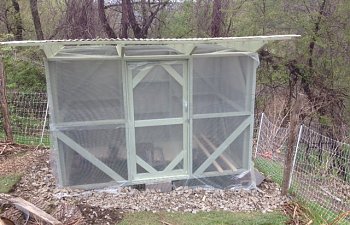Our coop was built Spring of 2014 based on plans we purchased for The Garden Coop (www.thegardencoop.com), a great coop design. We modified the plans to make "the run" into the whole actual open-air coop, that we cover with a heavy duty tarp and plastic in winter. I wanted a coop with a soil floor that I could use deep litter in, a coop that has good ventilation and would always smell fresh, and a coop that could be built securely on a hill. If it wasn't for the hill stipulation, I would have gone for a hoop coop with cattle panel, as it seems cheaper to make, but this works well for the site. We are in zone 6 Pennsylvania; the coop gets blasted with sun in the summer and it gets quite cold in the winter so I wanted it to be flexible for different types of weather. We really like how this coop has turned out.

Finished coop, protected with hardware cloth on the coop all year and electric fencing around run 3 seasons of the year. You can see the 2" x 3" roosting bars in the bottom right of the coop. We moved these higher in the coop as the deep litter built up and the birds got bigger.

Sanding one of the walls

Attaching fiberglass roofing panels. The coop is on a hill and to get it level involved lots of digging, cinderblocks, and gravel!! The bottom of the coop (between the 2' x 4' frame and soil line) offers airflow for the deep bedding since it is just hardware cloth.

The roof. These fiberglass panels are suspended over an "open roof" of hardware cloth, so ventilation is very good.

Adding a 2.5' apron of 1/2" hardware cloth to keep our digging predators if the electric fence is not on

Pullets in their new coop with tarp on for cold spring nights.

A dustbox that the hens used until they carved out their own patch of soil

For summer we left the coop totally open, with no tarp coverage. The roof was opaque enough to provide light and shade at the same time. Nipple waterer hanging outside. Next summer I plan to grow vines on the coop for additional shade (though I will have to protect them from the birds until they can withstand "chicken grazing!"

Auto chicken door senses daylight and lets chickens out in the morning/shuts them in at night. We looked at several models, but decided on one from www.AdorStore.com. Important predator protection feature, since the electric fence is off for the winter.

This fall I added lots of leaves to the coop as bedding. It is heating up a bit as deep litter. Roosts are shown at top of picture.


Deep fall litter. I just stir the leaves under the roosts slightly with a garden fork every 2 days and the coop continues to smell sweet and the poops disappear. This is "looking in" the human door, which is closed normally, unless I am going in to feed them or collect eggs.

Milk Crate nest boxes. I have fabric that hangs down over them for a little privacy.

The run in fall with the tarp back on and plastic sheeting stapled onto the frame, over the 1/2" hardware cloth. The tarp and sheeting block the wind but are not airtight, and the space between the frame and suspended fiberglass panels allows moisture to escape.
Finished coop, protected with hardware cloth on the coop all year and electric fencing around run 3 seasons of the year. You can see the 2" x 3" roosting bars in the bottom right of the coop. We moved these higher in the coop as the deep litter built up and the birds got bigger.
Sanding one of the walls
Attaching fiberglass roofing panels. The coop is on a hill and to get it level involved lots of digging, cinderblocks, and gravel!! The bottom of the coop (between the 2' x 4' frame and soil line) offers airflow for the deep bedding since it is just hardware cloth.
The roof. These fiberglass panels are suspended over an "open roof" of hardware cloth, so ventilation is very good.
Adding a 2.5' apron of 1/2" hardware cloth to keep our digging predators if the electric fence is not on
Pullets in their new coop with tarp on for cold spring nights.
A dustbox that the hens used until they carved out their own patch of soil
For summer we left the coop totally open, with no tarp coverage. The roof was opaque enough to provide light and shade at the same time. Nipple waterer hanging outside. Next summer I plan to grow vines on the coop for additional shade (though I will have to protect them from the birds until they can withstand "chicken grazing!"
Auto chicken door senses daylight and lets chickens out in the morning/shuts them in at night. We looked at several models, but decided on one from www.AdorStore.com. Important predator protection feature, since the electric fence is off for the winter.
This fall I added lots of leaves to the coop as bedding. It is heating up a bit as deep litter. Roosts are shown at top of picture.
Deep fall litter. I just stir the leaves under the roosts slightly with a garden fork every 2 days and the coop continues to smell sweet and the poops disappear. This is "looking in" the human door, which is closed normally, unless I am going in to feed them or collect eggs.
Milk Crate nest boxes. I have fabric that hangs down over them for a little privacy.
The run in fall with the tarp back on and plastic sheeting stapled onto the frame, over the 1/2" hardware cloth. The tarp and sheeting block the wind but are not airtight, and the space between the frame and suspended fiberglass panels allows moisture to escape.

